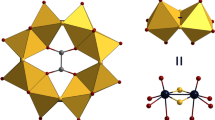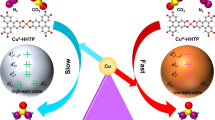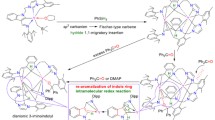Abstract
The synthesis and full structural characterisation is described of 3 dinuclear-based Cu(II) compounds bridged by methoxide anions, and flexible linear bis(pyrimidine)-α,ω-diaminoalkane ligands. The structures are dinuclear based in all cases, in which the bis(pyrimidine)diaminoalkane ligand chelates to 2 Cu(II) ions in the same dinuclear unit (N–C–C–C–C–C–N linker), or to two different dinuclear units (with the short N–C–C–N linker), thereby generating a polymeric chain. The magnetic exchange in the compounds is dominated by the alkoxido-bridged ligands, which generate a very strong antiferromagnetic coupling between the Cu(II) ions, resulting in diamagnetism at room temperature and below, and EPR silent behaviour.
Index Abstract
Dinuclear-based Cu(II) compounds with pyrimidine-based chelating ligands flexible linear bis(pyrimidine)-α,ω-diaminoalkane ligands are described, bridged by methoxide anions. The structures are dinuclear based in all cases, with the ligand chelating to 2 Cu(II) ions in the same dinuclear unit (N–C–C–C–C–C–N linker), or to 2 different dinuclear units (with short N–C–C–N linkers). The very strong antiferromagnetic magnetic exchange in all compounds is caused by the alkoxido-bridged ligands.

Similar content being viewed by others
Introduction
Binding of Cu(II) to heterocyclic ligands plays a very important role in many biological processes and has resulted in many biomimetic studies using heterocyclic ligands for many years. The used ligands were either monodentate [1, 2], or chelating ligands with flexible or rigid chains connecting the heterocyclic ligands [3]. The ability of Cu(II) (plasticity) to generate a variety of coordination geometries has allowed a variety of compounds, with many different anions, that in themselves can also be bridging [4]. The size of the ligand and in particular the length of the chain between the donor atoms has, of course, an influence on the coordination geometry of the Cu(II) ion and the whole structure in general. In the literature a wide variety of such flexible ligands is available, all having the general formula: L–(CH2) n –L (in which L is a heterocyclic nitrogen-donor ligand) have been reported, such as e.g. bis(benzotriazol-1-yl)alkanes [5], bis(imidazol-1-yl)alkanes [6, 7], bis(1,2,4-triazole-1-yl)alkanes [8–11], bis(4-pyridyl)alkanes [12, 13], N4-tetradentate-alkanes [14], and bis((iso)quinoline-carboxamido)alkanes [15, 16].
In an earlier research project from our laboratory bis-benzimidazolyl-alkanes were used extensively and successfully as flexible ligands and a number of different Cu(II) compounds have been reported together with their X-ray structures [17–25]. To explore this system further we now have designed the ligand N,N′-bis(2-pyrimidyl)-α,ω-polymethylenediamines (see Scheme 1) where the first atoms attached to the heterocyclic ligand is a nitrogen, and where the ligand itself has also H-bond acceptor possibilities. So, we have synthesized different Cu(II) compounds, and determined the structures of a few representative cases. So far, to the best of our knowledge, the X-ray structure of only one Ag(I) compound has been published with this class of ligands [26].
In this paper three new Cu(II) compounds are reported in detail together with their X-ray structure, physical, electronic and magnetic properties. The compounds involve the polymeric, dinuclear-based compound [Cu2(pyr2C2)2(OCH3)2(ClO4)2] n (1) and two isostructural dinuclear compounds, namely [Cu2(pyr2C5)2(OCH3)2(ClO4)2] (2) and [Cu2(pyr2C5)2(OCH3)2(CF3SO3)2] (3). The formation of polymeric, versus the dinuclear species, is discussed related to the spacer lengths between the 2 pyrimidine rings.
Experimental Section
General
C, H, N determinations were performed on a Perkin Elmer 2400 Series II analyzer. Ligand field spectra were obtained on a Perkin-Elmer Lambda900 spectrophotometer, using the diffuse reflectance technique, with MgO as a reference. EPR spectra were recorded on a Bruker-EMXplus electron spin resonance spectrometer (Field calibrated with DPPH (g = 2.0036)). FTIR spectra were obtained on a Perkin Elmer Paragon 1000 FTIR spectrophotometer equipped with a Golden Gate ATR device, using the reflectance technique (4,000–300 cm−1, res. 4 cm−1). Magnetic susceptibility measurements (5–300 K) were carried out using a Quantum design MPMS-5 5T SQUID magnetometer (measurements carried out at 1000 Gauss). Data were corrected for magnetization of the sample holder and for diamagnetic contributions, which were estimated from the Pascal constants. 1H NMR spectra were recorded using a DPX 300 Bruker (300 MHz) instrument.
Synthesis
The ligands were synthesized according to the general procedure described by García-Raso et al. [26]. All other chemicals were commercially available and were used without purification.
Synthesis of the coordination compounds: The compounds were prepared according to the following general procedure: 1.2 mmol of Cu(II) salt and 1.2 mmol of the ligand were each dissolved in 10 mL of methanol The Cu(II) salt solution was then added slowly to the ligand solution and filtered to remove any undissolved material. Usually after a few days to a week the products separated as very small or microcrystalline crystals. Suitable (micro)crystalline material was obtained for Cu(ClO4)2 with the ligand pyr2C2 and for Cu(ClO4)2 and Cu(CF3SO3)2 with the ligand pyr2C5. Attempts to synthesize (micro)crystalline products with other Cu(II) salts or with the ligands (pyr2C3) and (pyr2C4) failed so far. Suitable elemental analyses were obtained for all compounds.
Crystal Structure Determination and Refinements
A crystal was selected and mounted to a glass fiber using the oil-drop method; data were collected on a Nonius KappaCCD diffractometer (graphite-monochromated Mo-Kα radiation). The intensity data were corrected for Lorentz and polarization effects, for absorption and for extinction. The structures were solved by direct methods. The programs COLLECT [27], SHELXS-97 [28], SHELXL-97 [29] were used for data reduction, structure solution and structure refinement, respectively. Refinement of F 2 was done against all reflections. All non-hydrogen atoms were refined anisotropically. All H atoms were introduced in calculated positions and refined with fixed geometry with respect to their carrier atoms.
In case of compound 1 some disorder was found; the disordered C18 and C28 atoms were refined in the two positions each with population parameter 0.5. The refinement of compound 2 was found to be uneventful. The refinement of compounds 3 resulted in highly disordered parts, especially for the triflate group; this was refined as a rigid group in two positions with population parameters 0.75 and 0.25. The details are included in the supplementary information. One coordination site of the Cu atom appeared to be occupied by disordered methoxido and hydroxido groups. These groups were refined with population parameters 0.75 and 0.25. The hydroxide H atoms were located from a difference map.
Crystallographic data for the 3 compounds are presented in Table 1.
Results and Discussion
Description of the Crystal Structures
Description of Crystal Structure [Cu2(pyr2C2)2(OCH3)2(ClO4)2] n (1)
A thermal ellipsoid plot, together with the numbering scheme is presented in Fig. 1 with selected bond distances and angles in Table 2. The Cu atoms are crystallographically equivalent The geometry around each Cu(II) atom is distorted octahedral with the basal plane formed by two nitrogen atoms originating from two different ligands with a Cu–N distance which vary from 2.016(3) to 2.018(3) Ǻ and two oxygen atoms of the two bridging methoxido ligands with Cu–O distances which vary from 1.935(3) to 1.943(3) Ǻ. The apical positions are occupied by oxygen atoms of the bridging perchlorate anions with rather long semi coordination distances of 2.693(3) to 2.745(3) Ǻ. The Cu–Cu distance within the dinuclear units is 2.990(1), while the Cu–O–Cu angle is 100.9(1)°. In the crystal lattice the dinuclear Cu(II) units are linked up in linear, polymeric chains connected by the pyr2C2 ligands (see Fig. 2). Moderately strong intramolecular hydrogen bonds are formed by the amine nitrogen to the oxygen atoms of the perchlorate anions (N–H···O distances 2.985(5) to 3.071(5) Ǻ. The lone pair of the non-coordinating pyrimidine nitrogen is not involved in hydrogen bonding. Stacking interactions are also not observed.
Description of Crystal Structure of [Cu2(pyr2C5)2(OCH3)2(ClO4)2] (2)
A thermal ellipsoid plot, together with the numbering scheme is presented in Fig. 3, whereas selected bond distances and angles are presented Table 3. The compound is essentially dinuclear with methoxide as the strongest bridge. The other bridge is formed by the ligand, where one pyrimidine N binds to one Cu and the other binds to the other Cu, thereby forming a 14-membered ring, including the Cu–O–Cu group. The perchlorate, in this case is asymmetrically binding. The fifth position Cu is occupied by an oxygen atom of the perchlorato anion with a distance 2.550(3) Ǻ, whereas the sixth ligand is too far to be considered as semi-coordinating (Cu1A..O13 = 3.278 Ǻ). So the geometry around each Cu(II) atom is considered best as 5 coordinated with the basal plane formed by two nitrogen atoms of two different ligands with a Cu–N distance which vary from 2.015(3) to 2.018(3) Ǻ and two oxygen atoms of the two bridging methoxide anions with a Cu-O distance of 1.944(3) Ǻ. The Cu–Cu distance of the dinuclear unit is 3.007(1), while the Cu–O–Cu angle is 102.1(1)°. The basal planes in compound 2 are 168.5(1) and 171.8(1)°. The geometry of 5 coordinating compounds can be described by the parameter τ (in which the structural parameter τ describes the relative amount of trigonality; τ = 0 for square pyramid and τ = 1 for trigonal bipyramidal [30]). In this case τ = 0.06, so the geometry can be considered as a rather undistorted square pyramidal.
Relatively strong intramolecular hydrogen bonds are formed by the amine nitrogen to the oxygen atoms of the perchlorate anions (N–H···O distances 2.874(5) to 3.000(7) Ǻ). The lone pair to the pyrimidine nitrogen is not involved in H-bond acceptance.
The flexible space in the ligand clearly allows that in this case, contrary to compound 1 with the short spacer, the ligand can fold and bind intramolecularly. To find out the possible effect of the counter anion, the perchlorate was replaced by triflate, and the structure was also determined. The structure of the cation part is essentially the same. As the X-ray structure of [Cu2(pyr2C5)2(OCH3)2(CF3SO3)2] (3) has a severe disorder in the triflates and in the bridging methoxide, the details of this structure is presented as supplementary material only (see supplementary material figure S1 and table S1). The complete structures of both compound 2 and 3 are indeed dinuclear based with a CuIIO2CuII unit, basically similar to compound 1.
Ligand Field, Infrared Spectroscopy and EPR
The ligand-field transition measured as a solid with the diffuse reflectance technique against MgO, is observed as a strong broad band with a maximum of 16.7 × 103 cm−1 for compound 1 and as a broad band with a maximum at 17.2 and 16.6 × 103 cm−1 with a shoulder at 14.2 and at 14.0 × 103 cm−1 for compounds 2 and 3, respectively. These bands are in agreement with the distorted octahedral geometry for 1 and the slightly distorted “square pyramidal” geometries for 2 and 3 [31].
In the IR spectra of all three compounds a strong signal is observed at around 3,347–3,354 cm−1, which is assigned to the NH vibration of the ligand. The perchlorate anion strongest vibration for compound 1 and compound 2 is observed at about 1,050–1,060 cm−1. The ligand vibrations can clearly be assigned comparing with the free ligand. See figure S2 for a representative example.
The most characteristic vibrations of the triflate anion are the νas(S=O) bands in compound 3 and are observed at 1,289, 1,280, 1,267 cm−1 (triplet) and 1,234 cm−1, respectively. These bands are in agreement with the literature for monodentate and/or H-bonded triflate absorptions [18, 32]. In the Supplementary information some representative IR spectra are presented.
X-band EPR spectra of polycrystalline powders of the complexes were recorded at room temperature and 77 K in the range 0–800 mT. All three compounds are EPR silent both at RT and at 77 K in agreement with diamagnetism, as expected for methoxide-bridged Cu(II). Only a very weak S = ½ signal of a small mononuclear impurity (with parameters gperp 2.05, g∥ of 2.30 and A∥ of about 15.6 to 16.5 mT) can be seen (See figure S3). Such a species is often present in dinuclear bulk material. This observation is in agreement with other dinuclear methoxido-bridged compounds [17, 18, 25, 33, 34]. At 77 K in compound 2 only one very weak triplet signal is observed at 600 mT. Magnetic susceptibility measurements as a powder down to He temperatures, showed the compounds to be essentially diamagnetic below room temperature; heating of the sample to determine increasing thermal population of the triplet state was not possible, due to decomposition. NMR spectra of solutions in MeOH showed showed the ligand signals, with some broadening due to traces of mononuclear, paramagnetic Cu(II) in the solutions.
Concluding Remarks
In conclusion, of the 4 ligands synthesized (Scheme 1) only the ligand with 2 or 5 C atoms between the nitrogens did yield crystalline Cu(II) compounds. In both cases the Cu(II) ions are double bridged by a methoxide and the counter anion. In compound 1 the ligand pyr2C2 is not flexible enough to allow chelation of the dinuclear unit, and instead forms polymers. On the other hand, the ligand pyr2C5 ligand, with the C5-alkyl chain, can fold around the unit to form 2 times a bridge at the dinuclear unit; subsequently the perchlorate anion is not symmetrically bridging the 2 Cu(II) ions, but is semi-coordinating in fact monodentately to the Cu(II) ions. The ligands with 3 and 4 C atoms in the bridging part, were found unable to form crystalline coordination compounds.
Supplementary Material
IR and EPR spectra of a few representative compounds as well as the figure and bond distances and angles of compound 3 are given as supplementary material. Crystallographic data (excluding structure factors) for the structures reported in this paper have been deposited with the Cambridge Crystallographic Data Centre as supplementary publications no. CCDC: 698937,69838 and 698939, for compounds 1, 2 and 3, respectively. Copies of the data can be obtained free of charge on application to The Director, CCDC, 12 Union Road, Cambridge CB2 1EZ, UK (fax: int code +44(1223)336-033, E-mail: deposit@ccdc.cam.ac.uk).
References
Reedijk J (1970) Recl Trav Chim Pays Bas 89:605
Reedijk J (1971) Recl Trav Chim Pays Bas 90:117
Birker PJMWL, Helder J, Henkel G, Krebs B, Reedijk J (1982) Inorg Chem 21:357. doi:10.1021/ic00131a064
van Albada GA, Quiroz-Castro ME, Mutikainen I, Turpeinen U, Reedijk J (2000) Inorg Chim Acta 298:221. doi:10.1016/S0020-1693(99)00466-1
Zhou L, Liu X, Zhang Y, Li B, Zhang Y (2006) J Mol Struct 788:194. doi:10.1016/j.molstruc.2005.11.036
Duncan PCM, Goodgame DML, Menzer S, Williams DJ (1996) Chem Commun (Camb) 2127. doi:10.1039/cc9960002127
Wu JP, Yamagiwa Y, Kuroda-Sowa T, Kamikawa T, Munakata M (1997) Inorg Chim Acta 256:155. doi:10.1016/S0020-1693(96)05424-2
Li B, Xu Z, Cao Z, Zhu L, Yu K (1999) Trans Met Chem (Weinh) 24:622. doi:10.1023/A:1006988716200
van Albada GA, Guijt RC, Haasnoot JG, Lutz M, Spek AL, Reedijk J (2000) Eur J Inorg Chem 121. doi:10.1002/(SICI)1099-0682(200001)2000:1<121::AID-EJIC121>3.0.CO;2-D
Tang LF, Wang ZH, Chai JF, Jia WL, Xu YM, Wang JT (2000) Polyhedron 19:1949. doi:10.1016/S0277-5387(00)00457-5
Effendy, Marchetti F, Pettinari C, Pettinari R, Skelton BW, White AH (2003) Inorg Chem 42:112. doi:10.1021/ic025981q
Ghosh AK, Ghoshal D, Zangrando E, Chaudhuri NR (2007) Polyhedron 26:4195. doi:10.1016/j.poly.2007.05.042
Mukherjee PS, Konar S, Zangrando E, Mallah T, Ribas J, Chaudhuri NR (2003) Inorg Chem 42:2695. doi:10.1021/ic026150n
Uma V, Castineiras A, Nair BU (2007) Polyhedron 26:3008. doi:10.1016/j.poly.2007.02.020
Kajikawa Y, Azuma N, Tajima K (1998) Inorg Chim Acta 283:61. doi:10.1016/S0020-1693(98)00315-6
Kajikawa Y, Azuma N, Tajima K (1999) Inorg Chim Acta 288:90. doi:10.1016/S0020-1693(99)00051-1
van Albada GA, Lakin MT, Veldman N, Spek AL, Reedijk J (1995) Inorg Chem 34:4910. doi:10.1021/ic00123a028
van Albada GA, Smeets WJJ, Spek AL, Reedijk J (1997) Inorg Chim Acta 260:151. doi:10.1016/S0020-1693(96)05554-5
van Albada GA, Smeets WJJ, Spek AL, Reedijk J (1999) Inorg Chim Acta 288:220. doi:10.1016/S0020-1693(99)00074-2
van Albada GA, Veldman N, Spek AL, Reedijk J (2000) J Chem Crystallogr 30:69. doi:10.1023/A:1009506418398
van Albada GA, Smeets WJJ, Spek AL, Reedijk J (2000) Inorg Chim Acta 299:35. doi:10.1016/S0020-1693(99)00450-8
van Albada GA, Quiroz-Castro ME, Mutikainen I, Turpeinen U, Reedijk J (2000) Inorg Chim Acta 298:221. doi:10.1016/S0020-1693(99)00466-1
Riggio I, van Albada GA, Ellis DD, Spek AL, Reedijk J (2001) Inorg Chim Acta 313:120. doi:10.1016/S0020-1693(00)00374-1
van Albada GA, Riggio I, Mutikainen I, Turpeinen U, Reedijk J (2001) J Chem Crystallogr 30:793. doi:10.1023/A:1013276325343
van Albada GA, Mutikainen I, Riggio I, Turpeinen U, Reedijk J (2002) Polyhedron 21:141. doi:10.1016/S0277-5387(01)00903-2
Garcia-Raso A, Fiol JJ, Tasada A, Alberti FM, Molins E, Basallote MG, Máñez MA, Fernandez-Trujillo MJ, Sánchez D (2005) Dalton Trans 3763. doi:10.1039/b508260a
Nonius (2002) in COLLECT Nonius BV, Delft, The Netherlands
Sheldrick GM (1997) SHELXS-97. Program for crystal structure solution. University of Göttingen, Germany
Sheldrick GM (1997) SHELXL-97. Program for crystal structure refinement. University of Göttingen, Germany
Addison AW, Rao TN, Reedijk J, van Rijn J, Verschoor GC (1984) J Chem Soc, Dalton Trans 1349. doi:10.1039/dt9840001349
Hathaway BJ (1987) Comprehensive coordination chemistry. Pergamon Press Oxford, Oxford
van Albada GA, Smeets WJJ, Spek AL, Reedijk J (1998) J Chem Crystallogr 28:427. doi:10.1023/A:1021760420238
Amani Komaei S, van Albada GA, Mutikainen I, Turpeinen U, Reedijk J (1998) Eur J Inorg Chem 1577. doi:10.1002/(SICI)1099-0682(199811)1998:11<1577::AID-EJIC1577>3.0.CO;2-Y
Amani Komaei S, van Albada GA, Mutikainen I, Turpeinen U, Reedijk J (1999) Polyhedron 18:1991. doi:10.1016/S0277-5387(99)00060-1
Acknowledgements
The work described in the present paper has been supported by the Leiden University Study group WFMO (Werkgroep Fundamenteel Materialen Onderzoek). Financial support and coordination by the FP6 Network of Excellence “MAGMANet” (contract number 515767) is kindly acknowledged.
Open Access
This article is distributed under the terms of the Creative Commons Attribution Noncommercial License which permits any noncommercial use, distribution, and reproduction in any medium, provided the original author(s) and source are credited.
Author information
Authors and Affiliations
Corresponding author
Electronic supplementary material
Below is the link to the electronic supplementary material.
Rights and permissions
Open Access This is an open access article distributed under the terms of the Creative Commons Attribution Noncommercial License (https://creativecommons.org/licenses/by-nc/2.0), which permits any noncommercial use, distribution, and reproduction in any medium, provided the original author(s) and source are credited.
About this article
Cite this article
van Albada, G.A., van der Horst, M.G., Mutikainen, I. et al. Cu(II) Compounds with Pyrimidine-Based Chelating Ligands, Bridged by a Flexible Alkyl Spacer: Synthesis, Characterisation and X-Ray Structures of Methoxide-Bridged Dinuclear-Based Species. J Chem Crystallogr 39, 358–363 (2009). https://doi.org/10.1007/s10870-008-9484-x
Received:
Accepted:
Published:
Issue Date:
DOI: https://doi.org/10.1007/s10870-008-9484-x








